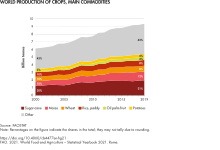Crop


A crop is a plant that can be grown and harvested extensively for profit or subsistence.[1] When the plants of the same kind are cultivated at one place on a large scale, it is called a crop. Most crops are cultivated in agriculture or hydroponics. Crops may include macroscopic fungus (e.g. mushrooms) and marine macroalga (e.g. seaweed), some of which are grown in aquaculture.
Most crops are harvested as food for humans or fodder for livestock. Some crops are gathered from the wild often in a form of intensive gathering (e.g. ginseng, yohimbe, and eucommia).
Important non-food crops include horticulture, floriculture and industrial crops. Horticulture crops include plants used for other crops (e.g. fruit trees). Floriculture crops include bedding plants, houseplants, flowering garden and pot plants, cut cultivated greens, and cut flowers. Industrial crops are produced for clothing (fiber crops e.g. cotton), biofuel (energy crops, algae fuel), or medicine (medicinal plants).
Important food crops

The importance of a crop varies greatly by region. Globally, the following crops contribute most to human food supply (values of kcal/person/day for 2013 given in parentheses): rice (541 kcal), wheat (527 kcal), sugarcane and other sugar crops (200 kcal), maize (corn) (147 kcal), soybean oil (82 kcal), other vegetables (74 kcal), potatoes (64 kcal), palm oil (52 kcal), cassava (37 kcal), legume pulses (37 kcal), sunflower seed oil (35 kcal), rape and mustard oil (34 kcal), other fruits, (31 kcal), sorghum (28 kcal), millet (27 kcal), groundnuts (25 kcal), beans (23 kcal), sweet potatoes (22 kcal), bananas (21 kcal), various nuts (16 kcal), soybeans (14 kcal), cottonseed oil (13 kcal), groundnut oil (13 kcal), yams (13 kcal).[3] Note that many of the globally apparently minor crops are regionally very important. For example, in Africa, roots & tubers dominate with 421 kcal/person/day, and sorghum and millet contribute 135 kcal and 90 kcal, respectively.[3]

In terms of produced weight, the following crops are the most important ones (global production in thousand metric tonnes):[5]
| Crop | 2000 | 2013 | 2020 |
|---|---|---|---|
| Sugarcane | 1,256,380 | 1,877,110 | 1,870,246 |
| Maize | 592,479 | 1,016,740 | 1,171,332 |
| Rice | 599,355 | 745,710 | 1,264,410 |
| Wheat | 585,691 | 713,183 | 760,931 |
| Potato | 327,600 | 368,096 | 359,124 |
See also
- General topics and economics
- Floriculture crops
- Guerrilla gardening
- Management practices
- Cover crop
- Crop destruction
- Crop residue
- Crop rotation
- Crop weed
- Kharif crops (crops specific to South Asia)
- Nurse crop
- Rabi crops (crops specific to South Asia)
- Genetic diversity
- Origin
References
- ^ "crop". Merriam-Webster.com Dictionary. Merriam-Webster. Retrieved 2017-06-20.
- ^ "World Food and Agriculture – Statistical Yearbook 2021". www.fao.org. doi:10.4060/cb4477en. Archived from the original on 2021-11-03. Retrieved 2021-12-13.
- ^ a b Food and Agriculture Organization of the United Nations, Statistics Division (2017). "FAOstats Food Supply - Crops Primary Equivalent".
- ^ "World Food and Agriculture – Statistical Yearbook 2021". www.fao.org. doi:10.4060/cb4477en. Archived from the original on 2021-11-03. Retrieved 2021-12-13.
- ^ FAO 2015. FAO Statistical Pocketbook 2015, ISBN 978-92-5-108802-9, p. 28
Further reading
- Sleper, David A.; Poehlman, John M. (2006). Breeding Field Crops. Blackwell Publishing. ISBN 9780813824284. Retrieved December 5, 2011.
